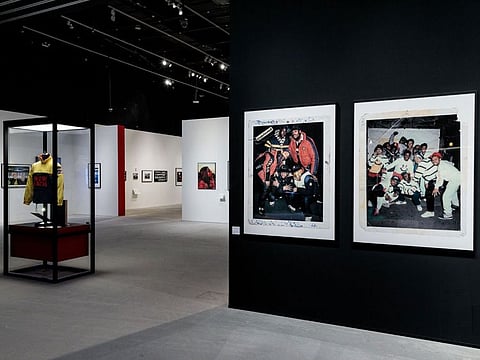Photography exhibit 'Contact High' showcases the history of hip hop in Abu Dhabi
Curator Vikki Tobak explains the importance of the project and what went into its making

“What the mainstream media at large now calls "hip hop" is a far cry from the creative culture that emerged following the gang truce between the warring factions of the South Bronx,” says Vikki Tobak, curator of ‘CONTACT HIGH: A Visual History of Hip-Hop’, a photography exhibition that runs in Abu Dhabi until May 31.
The show run by the Department of Culture and Tourism – Abu Dhabi features more than 150 images by over 60 photographers. The images are displayed alongside original contact sheets, offering rare insight into the subject and the genre.
Gulf News caught up with Kazakhstan-born, US-raised Tobak, who is the author of ‘Contact High’, about the idea behind the mammoth project of telling hip-hop’s story through photos and the challenges that came along with it.
Hip hop is so much more than a genre of music. What about it inspires you?
Hip hop has always been about making something out of little or nothing: two turntables, a microphone, a piece of cardboard, and a can of spray paint. Few knew that these simple items would produce the greatest American cultural innovation. As an immigrant kid to America where race and identity were always such a topic, hip hop answered a lot of questions for me. And now it’s a universal inspiration for kids expressing themselves. That freedom of expression and being truly yourself inspired me. The photographers in this exhibit understood that the artists they photographed were rebels, artists who understood the power of words and the power of imagery. To look back on certain photographers and iconography and see this vast archive of imagery tells an important, powerful story. Before hip hop became popular worldwide, many of the photographers in this exhibition came from the same communities as the artists. They were documenting neighbourhoods, block parties, clubs and that was important for the photographers to understand the whole culture, not just the music.
How did the idea for the showcase come about? Is it a reflection of the book? Or does it take the narrative forward?
I first decided to tell the story of hip-hop photography in book form and the exhibition just organically grew from there. When the team from Sole and Manarat Al Saadiyat offered to bring the exhibit to Abu Dhabi, I was super excited to share the story on a global scale. Today, the way we digest and create cultural imagery has radically changed. To be able to look deeper into the most recognized images of hip hop, is special. These are images that were made in moments of trust and mutual admiration. Some of the photographers in this book even started as tour managers and confidants; Estevan Oriol with Cypress Hill and Jorge Peniche with Nipsey Hussle. Some like Gordon Parks were already legends by the time they shot hip-hop. But most of those involved will say, first and foremost, we were fans of the music and the culture. Even if the rest of the world had yet to understand the lasting legacy and excellence of the culture that was being created.
What are some of your favourite photos from the exhibition?
Barron Claiborne’s “King of New York” image of Biggie Smalls is probably the most recognised image in hip-hop. I like to call it ‘hip-hop’s Mona Lisa’. I love this image because it has a deep story: at the time it was taken, Barron wasn’t exactly known for photographing rappers. When Biggie showed up at his studio near Wall Street for a Rap Pages magazine shoot. He felt images of rappers had been cliché, and Claiborne “wasn’t interested in stereotypical negative imagery of black people”.
To him, the rapper was “a big West African king,” and he wanted him portrayed as regal in the photos. The photo was about portraying an artist in a lasting way and pushing viewers to look deeper. It’s is about hip-hop, but it's also beyond that. This was simply about photographing Biggie as the King of New York. He is depicted as an almost saint-like figure.
It’s a fascinating narrative, but then you look at the contact sheet and it gets even better. There’s a frame on the contact sheet showing a crowned Biggie, head cocked to his left, bearing a grin so bright it’s blinding. That one shot of Biggie smiling on the contact sheet – for people who knew Biggie, whenever they see that, ‘that’s the Biggie I know’ … not the stern one on the album and Rap Pages magazine cover.
Was it difficult to navigate the story, considering it’s such a male-dominated field, to be able to do justice to the women in it?
Well, for starters, I am a woman telling this story and curating the show so already we are starting in a place where the consideration of women is a priority. I’ve always made it a priority to have women on my team – from editors I’ve worked with to the amazing photographers in the ‘Contact High’ book and exhibition – the contributions of women on all fronts, whether in front or behind the camera, is so important to this story.
It’s true that hip-hop is perceived as a boys club but women have been part of the story from day one. Today, the success of female artists represents a significant shift in the culture, revealing there are fewer limitations for women than ever before. Nowadays, women are more empowered. They can move through the world and operate however they want. More than 45 years after hip hop got its start in the Bronx, a new wave of women are dominating the charts and challenging the hypermasculine culture by embracing their agency. Artists like Cardi B, Megan Thee Stallion, City Girls, and Doja Cat are changing the game. Also artists like Nicki Minaj and Salt-N-Pepa, who are all represented in the exhibition. One thing I’m especially proud of is how many women photographers we have in this show: Janette Beckman, Angela Boatwright, Lisa Leone, Sophie Bramly, Martha Cooper, Adama Delphine Fawundu, Sue Kwon, Sheila Pree Bright, and Ravie B, among others.
What were some of the challenges you faced?
As responsibility to the images, I visited dozens of archives and was surprised at just how many images are still out there. It was a challenge to dig into these archives and find the deeper story. Some of these photographers hadn’t looked at their contact sheets in years and were surprised at what they saw looking at the outtakes after so many years. These rolls of film, many stored away in shoeboxes and closets were holding iconic moments tucked away, still unprocessed. The in-between shots on the contact sheets tell a deeper story; they show the intimacy between the photographer and the subject. And they show just how much hip hop has evolved.
As hip hop has evolved from subculture to mainstream cultural force - influencing just about every facet of life — ideas, fashion, visual language in general - these images are more important than ever. The culture has morphed and changed as things do over time, but these pictures speak to the grassroots nature of it. What the mainstream media at large now calls "hip hop" is a far cry from the creative culture that emerged following the gang truce between the warring factions of the South Bronx. In the beginning, it wasn’t celebrity driven, the rappers were on equal footing with the dancers, graffiti artists and DJs.
Original contact sheets are hard to come by, how did you manage to procure them – tell us an anecdote about one such acquisition?
Indeed, I had to reach out to each photographer individually and gain access to their archive. In getting access to these original and unedited contact sheets, we can see how photographers thought about sequencing, when to click the shutter and how they took photos from different perspectives. Contact sheets are like being let in on a secret. Photographers don’t often show their contact sheets, it’s quite vulnerable to show your imperfections but that’s what makes them so powerful. One amazing find was Al Pereira’s photograph of Tupac and Nas from 1993. I had reached out to Al to see the contact sheet for this well known Biggie image he has and lo and behold on that contact sheet was the only photograph ever of Nas and Tupac together. When I posted it to Instagram, everyone thought it was photoshopped because it seemed too good to be true.
How would you say hip-hop photography has changed over the years?
Photography has changed so much - the shift to digital photography has made the contact sheet almost obsolete. Now, in this age of Instagram, Lightroom and digital technology, the “decisive moment” is determined through an entirely different process. So please indulge in the in-between moments that manifested a culture. The posed and moments of candor that reveal the intimacy and emotion of a music that has changed culture and the images that will stay in the collective conscious for years to come. When you look at these contact sheets, you see artists being frustrated, working it out, making mistakes… The public often only sees the finished product, the perfect shot, the perfect song. I wanted to hear about the messy parts, the hardship and the overcoming. That’s a universal story for both the artists and the photographers. Photographers understand that their photos are part of a larger conversation about identity, culture, race and all that hip hop has manifested as part of the broader cultural document
What’s next for the exhibition after UAE?
I really hope this exhibition can travel around the world to other cities and share this important culture to inspire the youth. This fall, the exhibit comes back to the states and opens at Seattle’s Museum of Pop Culture (MoPOP). Personally, I’m working on an upcoming book about the history of jewellery in hip hop, which will be out this Fall.
Sign up for the Daily Briefing
Get the latest news and updates straight to your inbox









